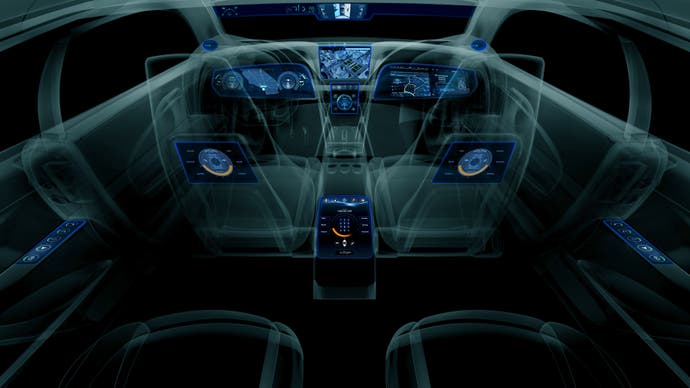Is Nvidia Tegra X1 the next big thing for mobile graphics?
iPad Air 2, Shield Tablet and last-gen console effortlessly bested according to initial benchmarks.
Nvidia has unveiled Tegra X1 - an all-in-one mobile processor combining state-of-the-art octo-core ARM CPU architecture with the most advanced graphics hardware on the market. Based on the Nvidia Maxwell graphics tech found in the GTX 980 and GTX 970, Tegra X1 offers around 500 GFLOPs of rendering power, leaving last-gen console for dust.
Tegra X1 represents a generational leap in performance over the current standard bearers in the mobile market - the Apple A8X found in the iPad Air 2, along with Nvidia's own Tegra K1, which powers Shield Tablet and the Google Nexus 9. CPU-side, the quad-core ARM Cortex A15 arrangement found in the 32-bit version of Tegra K1 is swapped out for ARM's latest A57 architecture - four cores backed up by an additional quartet of lower-power A53s. These are standard 'off the shelf' parts with minor Nvidia enhancements. The fact it is not a part of X1 at all calls into question the fate of Nvidia's own 'Denver' ARM design, so far found only in the Nexus 9.
It's in the GPU that things get more interesting, and where a revised development focus within Nvidia pays the most dividends. In creating its Maxwell GPU architecture, the firm has concentrated efforts on developing its graphics tech for mobile first and foremost. The idea is that by concentrating on efficiency - in terms of both silicon die space and power efficiency - Nvidia creates state-of-the-art mobile graphics tech that scales up beautifully for laptop and desktop applications.

While the top-end desktop GTX 980 uses 16 SMM CUDA clusters, with a mammoth 2048 cores, Tegra X1 is necessarily downscaled, using two SMMs and 256 cores, said (according to calculations from Anandtech) to be running at speeds in the region of 1GHz. On paper at least, the outgoing Tegra K1 matched last-gen console performance and according to Nvidia's internal metrics at least, Tegra X1's move to Maxwell sees a 2x performance per watt improvement, alongside anything up to a 2x performance boost.
Tegra K1 was a fantastic mobile processor, but its Achilles Heel was definitely power consumption - Shield Tablet's state-of-the-art processing was undeniable, but battery life took a pummelling when the GPU was really pushed to its limits in titles such as Trine 2. Tegra X1 should see an improvement here, not just because of Maxwell's power efficiency enhancements but also because it is fabricated on the new 20nm production process, meaning more transistors can be packed onto the silicon, with a much lower power requirement compared to the 28nm technology used for K1.
Another key enhancement found in X1 involves the transition from LPDDR3 memory to the new LPDDR4 standard, which presents a two-fold advantage over Tegra K1. There's a 40 per cent power efficiency boost, but more importantly, internal bandwidth rises from K1's 14.9GB/s to 25.6GB/s. Nvidia is targeting X1 for ultra-resolution displays, so the GPU's ROP count is also doubled from the eight found in K1, to 16 in the new processor. There's a definite 4K focus here - not just in terms of rendering, but in media support too, with the new h.265 compression standard supported for decoding at 4K video at 60fps.

So just how powerful is Tegra X1's graphics tech? Anandtech has posted benchmarks that, when averaged, show a 64 per cent performance boost over the iPad Air 2 and a 72 per cent increase over the Shield tablet, though in both cases, individual benches do show a 2x performance increase, or something very close to it.
Overall, exciting stuff - but in our opinion, both iOS and Android find themselves in a curious position now, to the point where benchmarks reveal performance increases from one generation to the next that are simply not reflected at all in the user experience. The sheer horsepower afforded to the latest devices like the iPad Air 2 and the Shield Tablet is breathtaking, but applications that tap into even a fraction of their power are thin on the ground. Nvidia's solution here is to expand into new markets, specifically the automotive industry. The company has history here: the brilliant Tesla Model S features both Tegra 2 and Tegra 3 hardware powering its cockpit displays, but the announcement of Nvidia's new Drive CX and Drive PX initiatives takes that to a whole new level.
Drive CX is a new platform design to power a high-end car's instrumentation, navigation and in-car entertainment. Tegra X1 may sound like overkill for this, but it also deals with cellular communications, Bluetooth, audio and onboard cameras. Drive PX sees two X1s operating in parallel, handling tasks such as auto-parking and environment processing (in theory, combined with surround cameras, the tech could warn you of upcoming hazards, red lights etc) driven by neural net-powered object recognition. The Drive platforms are expected to begin production sometime in 2016, and we'll doubtless find Tegra X1 tablets on the shelves later this year.

